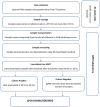Zoonotic tuberculosis in a high bovine tuberculosis burden area of Ethiopia
- PMID: 37771833
- PMCID: PMC10525399
- DOI: 10.3389/fpubh.2023.1204525
Zoonotic tuberculosis in a high bovine tuberculosis burden area of Ethiopia
Abstract
Background: Tuberculosis (TB) is a major cause of ill health and one of the leading causes of death worldwide, caused by species of the Mycobacterium tuberculosis complex (MTBC), with Mycobacterium tuberculosis being the dominant pathogen in humans and Mycobacterium bovis in cattle. Zoonotic transmission of TB (zTB) to humans is frequent particularly where TB prevalence is high in cattle. In this study, we explored the prevalence of zTB in central Ethiopia, an area highly affected by bovine TB (bTB) in cattle.
Method: A convenient sample of 385 patients with pulmonary tuberculosis (PTB, N = 287) and tuberculous lymphadenitis (TBLN, N = 98) were included in this cross-sectional study in central Ethiopia. Sputum and fine needle aspirate (FNA) samples were obtained from patients with PTB and TBLN, respectively, and cultures were performed using BACTEC™ MGIT™ 960. All culture positive samples were subjected to quantitative PCR (qPCR) assays, targeting IS1081, RD9 and RD4 genomic regions for detection of MTBC, M. tuberculosis and M. bovis, respectively.
Results: Two hundred and fifty-five out of 385 sampled patients were culture positive and all were isolates identified as MTBC by being positive for the IS1081 assay. Among them, 249 (97.6%) samples had also a positive RD9 result (intact RD9 locus) and were consequently classified as M. tuberculosis. The remaining six (2.4%) isolates were RD4 deficient and thereby classified as M. bovis. Five out of these six M. bovis strains originated from PTB patients whereas one was isolated from a TBLN patient. Occupational risk and the widespread consumption of raw animal products were identified as potential sources of M. bovis infection in humans, and the isolation of M. bovis from PTB patients suggests the possibility of human-to-human transmission, particularly in patients with no known contact history with animals.
Conclusion: The detected proportion of culture positive cases of 2.4% being M. bovis from this region was higher zTB rate than previously reported for the general population of Ethiopia. Patients with M. bovis infection are more likely to get less efficient TB treatment because M. bovis is inherently resistant to pyrazinamide. MTBC species identification should be performed where M. bovis is common in cattle, especially in patients who have a history of recurrence or treatment failure.
Keywords: Mycobacterium bovis; Mycobacterium tuberculosis; cattle; central Ethiopia; zoonosis.
Copyright © 2023 Ayalew, Habtamu, Melese, Tessema, Ashford, Chothe, Aseffa, Wood, Berg, Mihret and The ETHICOBOTS Consortium.
Conflict of interest statement
The authors declare that the research was conducted in the absence of any commercial or financial relationships that could be construed as a potential conflict of interest.
Figures
References
-
- World Health Organization . Global Tuberculosis Report. Geneva: WHO; (2022).
-
- World Health Organization (WHO), Food and Agriculture Organization of the United Nations (FAO) and World Organisation for Animal Health (OIE). Roadmap for zoonotic tuberculosis . (2017).
MeSH terms
Grants and funding
LinkOut - more resources
Full Text Sources



